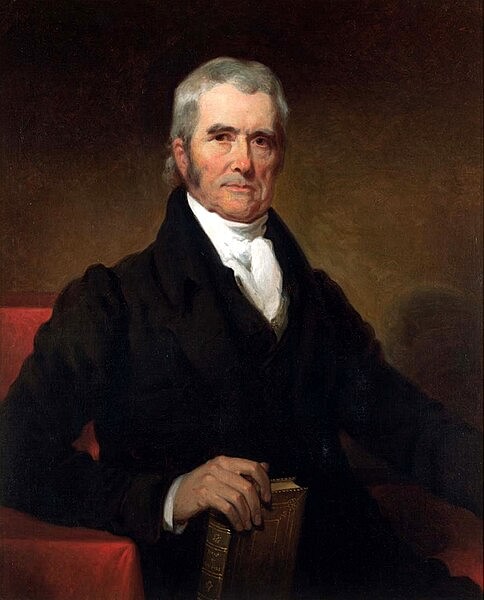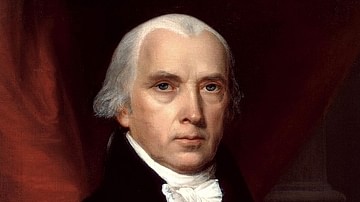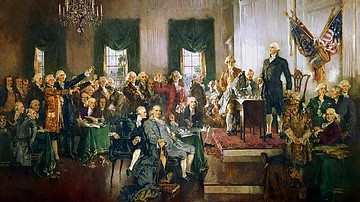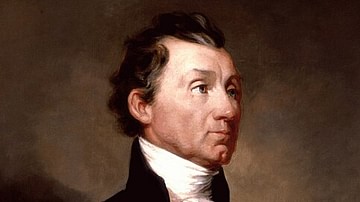
Marbury v. Madison (1803) was a landmark decision of the United States Supreme Court that established the principle of judicial review. In the decision, written by Chief Justice John Marshall, the court struck down a congressional statute as unconstitutional for the first time in US history, thereby establishing the United States Constitution as a legal – not just a political – document.
Prior to the Marbury case, the Supreme Court was the weakest branch of the federal government. It had reviewed only 63 cases in the twelve years before 1801 and was viewed as a useless, aristocratic institution by many ardent Republicans, some of whom sought to do away with the federal judiciary entirely. In February 1803, the Court heard Marbury v. Madison, a case in which Secretary of State James Madison had withheld a commission for a federal office from a political opponent, William Marbury; Marbury had petitioned the Supreme Court to issue a writ of mandamus, which would force Madison to deliver the commission. Chief Justice Marshall, writing for a unanimous court, ruled that while Marbury was legally entitled to the commission, the Supreme Court could not help him by issuing a writ of mandamus. The statute that empowered it to do so – Section 13 of the Judiciary Act of 1789 – was, in fact, in conflict with Article III of the Constitution. For this reason, the Marshall Court took the unprecedented step of striking down Section 13.
By striking down a congressional statute, Marshall had established the principle of judicial review – that is, a court's ability to uphold or strike down a law based on its constitutionality. Another major consequence was that the US Constitution was now no longer just a political document – a statement of the political ideals of the United States – but was a legal document as well, one which all federal and state courts and legislatures must adhere to. The case is therefore considered the single most important decision in US constitutional law and remains one of the most significant cases in the history of the US Supreme Court.
Background: Creating a Federal Judiciary
The federal judiciary – conceived at the Constitutional Convention of 1787 and enshrined in Article III of the resultant United States Constitution – proved to be a controversial institution in the first decade of its existence. Americans were generally predisposed to distrust judges, whose flowing robes, rigid court protocols, and high benches smacked of the monarchism all too recently cast aside. It was not lost on the people that the federal judges were modeled closely off the colonial magistrates they had replaced, who themselves had been selected by the king and had – in the patriotic memories of the Americans, at least – arbitrarily wielded their authority. Thomas Jefferson, in 1776, referred to judicial decisions as "the eccentric impulses of whimsical, capricious, designing men" who were looking after political interests rather than enforcing the law (Wood, 402). This suspicion was carried over to the new American courts, whose judges were, in many instances, appointed rather than elected and served life tenures rather than limited terms of office, neither aspect seeming to hint at an enlightened government institution.
The makeup of this controversial body was roughly outlined in Article III of the Constitution, which vested judicial power in "one supreme court" of the United States as well as "such inferior courts as the Congress may from time to time ordain and establish". The Supreme Court was granted original jurisdiction – or the power to hear a case for the first time – over cases that involved ambassadors, public officials, or individual states as parties in the suit. It was also given appellate jurisdiction – or the power to hear cases on appeal – over a broader range of suits involving constitutional or federal law. Although Article III left things rather vague, the courts were fleshed out by the First Congress in the Judiciary Act of 1789. This act created a system of federal circuit courts and district courts under the Supreme Court and expounded on the powers of the judiciary. Section 25, for instance, allowed federal courts to overturn any state law or state court ruling that violated a federal treaty. Additionally, Section 13 of the Judiciary Act – which will become important later – allowed the judiciary to issue legal orders called writs of mandamus to government officials, which would force them to adhere to federal law.
While this expansion of judicial authority certainly ruffled a few feathers, the judiciary was still by far the weakest branch of the federal government. Neither Article III of the Constitution nor the Judiciary Act of 1789 had given the Supreme Court the power of judicial review. This refers to a court's ability to declare an act of the executive or legislative branch to be unconstitutional and therefore invalid, a function that the Supreme Court is best known for today and considered a vital part of the checks and balances of federal power. Without this authority, the Supreme Court wielded minimal influence in the first decade of its existence and was widely disregarded by the other two branches. In fact, between 1789 and 1801, it heard only 63 cases, none of which had any long-lasting importance. Since the federal courts were still seen as aristocratic bodies that hindered the rights of the states, some hardcore Republicans wanted to do away with the federal judiciary altogether. This was how matters stood when the US presidential election of 1800 swept such Republicans into power, placing the judiciary in jeopardy.
Case Origins: The Midnight Judges
By the end of the year 1800, it was clear that President John Adams had lost the national election and that his political faction, the Federalist Party, would lose power for the first time since the ratification of the Constitution. The Federalists had long been criticized for their aristocratic, pro-British positions and had lost the confidence of many Americans after such controversial policies as the Jay Treaty (1795) and the Alien and Sedition Acts (1798). Now, with their nemesis Thomas Jefferson and his radical Democratic-Republican Party poised to take power, the Federalists feared that it would be a long time before they would be able to regain control of the national government. To avoid losing influence entirely, the Federalist-controlled Congress created 60 new positions in the federal judiciary, which President Adams proceeded to fill with Federalists.
These appointments – forever after known as the 'midnight judges' – were confirmed en masse by the Senate on 3 March 1801. The appointees' commissions were quickly written out and signed by President Adams and then handed off to Secretary of State John Marshall, who had less than 24 hours to deliver them before Jefferson's inauguration. Marshall was a good-humored, intelligent man from the Virginia frontier, a stalwart Federalist who believed in the necessity of a strong national government and had long been valued by Adams for his diligence and loyalty. Adams had made him secretary of state in May 1800 and, half a year later, appointed him chief justice of the Supreme Court as well, after the resignation of the previous officeholder Oliver Ellsworth. Now, still carrying out the duties of secretary of state even as he donned the robes of the chief justice, Marshall rushed to deliver the commissions before the end of Adams' presidency. Although he got most of them out, he was unable to deliver all of them before Jefferson took office on 4 March 1801.
President Jefferson looked on Adams' 'midnight judges' with suspicion, viewing the appointments as a pathetic attempt to pack the courts with Federalists. As a result, he instructed his own secretary of state, James Madison, to not deliver the remaining commissions. William Marbury, a prominent Maryland Federalist, was one of the 'midnight judges' who had not received his commission before Jefferson had taken office. Arguing that he had already been nominated by a president and confirmed by the Senate, Marbury claimed that the office was his and that the Jefferson administration had no legal authority to withhold his commission. When it became clear that the State Department would not give him his commission voluntarily, Marbury turned to the Supreme Court. He argued that, by invoking Section 13 of the Judiciary Act of 1789, the Supreme Court could force Madison to deliver his commission by issuing a writ of mandamus.
The Question
As Marbury prepared to petition the Supreme Court for his commission, the new chief justice was attempting to reform that court and increase its legitimacy. Shortly after being sworn in, Marshall did away with the court's practice of issuing seriatim opinions, whereby each justice would write his own, separate opinion in any given case. Although this was common practice for courts at the time, Marshall believed that the Supreme Court's decisions would bear more weight if they were delivered with one voice; from now on, the Supreme Court would issue a single majority opinion, which was often written by Marshall himself. Additionally, the chief justice sought to diminish the Court's reputation as an aristocratic body by replacing the gaudy scarlet and ermine robes worn by the justices – modeled after the robes worn by royal magistrates in England – with plain black robes, like the ones worn by Virginia judges. Such was the status of the Supreme Court when it finally heard Marbury v. Madison in February 1803. The question posed by that case promised not only to put the legitimacy of Marshall's court to the test but also threatened to undo all his progress if he answered it unwisely.
The question was threefold:
- Did Marbury have the right to his commission?
- If so, did the law offer a remedy for him to obtain it?
- If such a remedy existed, was it within the Supreme Court's power to issue it?
The reason why this question was so dangerous was because either way Marshall answered, he risked weakening the already precarious authority of the Supreme Court. On one hand, he could answer in favor of Marbury and issue a writ of mandamus to compel Madison to deliver the commission. However, the Jefferson administration had already made it clear that it was prepared to ignore any such writs of mandamus – issuing one would only humiliate the Supreme Court and further diminish whatever small amount of legitimacy it had. On the other hand, Marshall could deny Marbury's claims and rule in favor of the State Department. But this would certainly lead to the perception of the Court as a presidential tool, cowed into submission by the executive branch; this, too, would reduce the Supreme Court's legitimacy as an independent branch of government. If he hoped to come out on top, Marshall would have to delicately weave an answer so airtight that the Court's authority could not be challenged.
The Decision
The Supreme Court reached a unanimous decision on 24 February 1803, one that would go down as among the most brilliant and consequential decisions in its history. The opinion, written by Marshall himself, began by addressing the first part of the question and found that Marbury was indeed entitled to his commission. All the correct procedures had been adhered to – the appointment had been approved by Congress, the commission signed and sealed by a sitting president. The fact that it had not been delivered in time was inconsequential, with Marshall arguing that the delivering of the commissions had always been a formality, not a necessity for the appointee to take office. Therefore, Marshall proclaimed, Jefferson and Madison had no right to deny the office to Marbury, as the president "cannot at his discretion sport away the vested rights of others" (Wood, 441).
Having determined that Marbury was in the right, Marshall turned to the second part of the question: was there any legal remedy Marbury could use to obtain his commission? Once again, the chief justice answered in the affirmative. "It is a general and indisputable rule," he wrote, "that where there is a legal right, there is also a legal remedy by suit or action at law whenever that right is invaded". In this case, the remedy was indeed a writ of mandamus, which, if issued, would compel Madison to deliver Marbury's commission. The stage, it seemed, was set for a confrontation between the Marshall Court and the Jefferson administration. But then, Marshall turned to the third and final part of the question: having decided that such a remedy did exist, was it within the Supreme Court's power to use it? Here, Marshall surprised everyone with his answer: no, the Supreme Court had no authority to force Madison to deliver the commission with a writ of mandamus.
On the surface, this conclusion seems to have been wrong; Section 13 of the Judiciary Act of 1789 clearly gave the Supreme Court the power to issue writs of mandamus in such cases. But Marshall, having consulted Article III of the Constitution, had a hard time reconciling the two documents. For instance, Article III stipulates that the Supreme Court has jurisdiction only in cases involving "ambassadors, other public Ministers and Consuls and those in which a State shall be a party…in all other cases before mentioned the supreme court shall have appellate jurisdiction". Therefore, since William Marbury was neither an ambassador, public minister, nor a representative of a state, the case Marbury v. Madison actually fell outside the Supreme Court's original jurisdiction. But since Section 13 of the Judiciary Act of 1789 had given the Court authority to issue writs of mandamus in cases like Marbury's, that meant that Section 13 was in conflict with Article III of the Constitution; thus, Marshall concluded, Section 13 of the Judiciary Act was unconstitutional.
Having reached such a conclusion, Marshall then took the unprecedented step of striking down that section of the Judiciary Act, declaring it to be invalid. His reasoning for doing so was that the American people regarded the Constitution as "the fundamental and paramount law of the nation", which meant that any "law repugnant to the Constitution….is void; and that courts, as well as other departments, are bound by that instrument". With this decision, Marshall had surrendered the power given to the Court by the 1789 law and had handed the case victory to Jefferson and Madison (although, by asserting that Marbury was entitled to the office, he had not let them get away without a slap on the wrists). Yet Marshall had given the Supreme Court something much more important: the power of judicial review. Although this would be the only instance in Marshall's tenure where the Supreme Court would strike down a congressional law, it would set a precedent for the Supreme Court to interpret the Constitution while upholding or striking down state or federal statutes based on that interpretation. It was a monumental development, and perhaps the single most important decision in the history of US constitutional law.
Conclusion
In summation, the case Marbury v. Madison had several significant outcomes. Most immediately, it avoided a reduction of the Supreme Court's legitimacy; by acknowledging that Marbury was in the right, Marshall had avoided backing down and looking weak before executive power, but neither did he risk humiliation by issuing a writ of mandamus that was clearly going to be ignored. Instead, he had set a precedent for the Supreme Court's power of judicial review, which is perhaps its best-known and most important role in government today. Finally, the Marbury v. Madison decision turned the Constitution from being viewed as a purely political document – a simple statement of the nation's principles – into a legal document that all states and federal institutions had to abide by. The case certainly had a major impact on the development of the United States judiciary and the birth of constitutional law.










